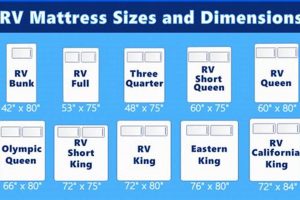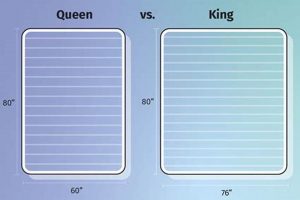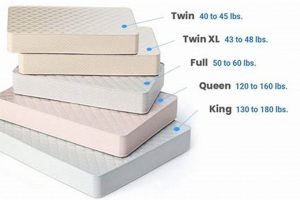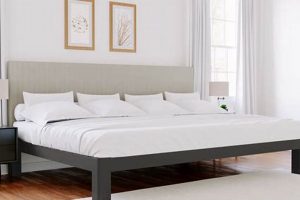A sleeping surface significantly wider and longer than a standard full or queen model, this product offers expansive personal space. Its dimensions typically measure 76 inches wide and 80 inches long, providing ample room for individuals and couples. For example, those who co-sleep with children or pets often find this size accommodates everyone comfortably.
The advantages of this larger sleeping arrangement extend beyond mere comfort. Increased personal space can lead to reduced sleep disturbances caused by a partner’s movements. Historically, as living spaces increased in size, demand for larger beds grew, reflecting a desire for enhanced sleep quality and individualized comfort within a shared bedroom. This size also caters to individuals of larger stature, allowing for full extension without encroaching on the bed’s edges.
The subsequent sections will delve into the specific considerations for selecting this size of bedding, including the types of mattresses available, optimal bedroom dimensions, compatible bedding options, and the overall investment relative to its potential long-term benefits for sleep and well-being.
Selecting the Optimal Oversized Bed
The following guidelines are designed to assist in making an informed decision when considering an oversized bed purchase.
Tip 1: Measure the Bedroom Dimensions: Ensure the room can comfortably accommodate the bed’s considerable footprint. Allow sufficient space for movement around the bed and the placement of other furniture. A room smaller than 12 feet by 12 feet may feel cramped.
Tip 2: Consider Sleeping Preferences: Assess individual or shared sleeping styles. If one partner is a restless sleeper, the increased surface area can minimize disturbances.
Tip 3: Research Mattress Types: Explore the range of available mattress technologies, including innerspring, memory foam, latex, and hybrid models. Each offers distinct levels of support, contouring, and temperature regulation.
Tip 4: Evaluate Foundation Requirements: Determine the appropriate foundation or bed frame needed to adequately support the mattress. Some models require specialized support systems to prevent sagging or damage.
Tip 5: Budget Accordingly: Factor in the cost of not only the mattress itself but also associated expenses such as bedding, sheets, a frame, and potential delivery charges. Oversized bedding typically carries a higher price point.
Tip 6: Check Doorways and Stairwells: Before purchasing, measure doorways and stairwells to confirm the mattress can be maneuvered into the intended room. Some mattresses may require professional delivery and setup.
Tip 7: Consider Long-Term Health: Properly selected, an oversized mattress can promote better spinal alignment and reduce pressure points, potentially contributing to improved long-term physical well-being.
In summary, careful consideration of room size, sleeping habits, mattress type, support needs, and budget constraints is essential for a satisfactory purchase. These steps help ensure the oversized bed provides a worthwhile investment in sleep quality.
The subsequent section will explore the maintenance and care considerations associated with this significant bedding investment.
1. Dimensions
The defining characteristic of this size is its dimensions: 76 inches in width and 80 inches in length. These specific measurements directly influence the level of comfort and suitability for various users. For example, couples who prefer ample personal space during sleep often select this size precisely because its width allows for undisturbed movement without encroaching on a partner’s area. Furthermore, individuals of taller stature benefit from the 80-inch length, enabling full extension without feet dangling over the edge. The spatial area provided directly correlates to improved sleep quality through minimized physical restrictions.
The room size must accommodate these dimensions. A bedroom that is too small will feel cramped and potentially obstruct walkways or impede door swing. As a practical consideration, measure the bedroom to ensure sufficient clearance around the bed after placement. A standard recommendation is a minimum room size of 12 feet by 12 feet. Moreover, the dimensions are critical when selecting bedding; standard queen-size sheets will not fit, necessitating the purchase of specifically sized linens, quilts, and comforters. Failure to account for these dimensional disparities results in improperly fitted bedding and compromised comfort.
In summary, the dimensions are not merely a numerical specification but a fundamental attribute that dictates comfort, spatial considerations, and compatibility with accompanying furnishings. Understanding and accounting for these dimensions is paramount when choosing this sleeping arrangement to ensure a suitable and restful sleep environment. The dimensional aspect underscores a direct relationship with user satisfaction and practical implementation.
2. Support System
The support system is a critical determinant of a mattress’s ability to provide proper spinal alignment and distribute weight evenly, particularly crucial in oversized models due to the increased surface area. A poorly designed support system in a product of this size can lead to localized sagging, discomfort, and potential back pain. For example, an innerspring system with insufficient coil gauge in a queen-size mattress might perform adequately, but when scaled to king size, may exhibit significant compression and inadequate support under heavier weight distribution. This necessitates careful evaluation of the internal structure.
Various support system options exist, each offering distinct advantages. Innerspring systems, utilizing interconnected or individually wrapped coils, provide varying degrees of firmness and responsiveness. Foam-based systems, including memory foam and latex, contour to the body’s shape, potentially reducing pressure points. Hybrid systems combine elements of both, aiming for a balance of support and comfort. The selection of a support system should correlate with individual sleep preferences, body weight, and any pre-existing musculoskeletal conditions. A side sleeper, for instance, may benefit from a more conforming foam system to alleviate pressure on the shoulders and hips, while a back sleeper might prefer the firmer support of an innerspring or hybrid model to maintain spinal alignment.
In summation, the support system is not a mere component but rather the foundational element dictating the performance and longevity of the mattress. Selecting an appropriate support system tailored to individual needs and the product’s dimensions is essential for ensuring optimal comfort, minimizing potential health issues, and maximizing the investment in a mattress designed for extended use. The absence of a well-engineered support structure negates the intended benefits of a king-size form
at, rendering its increased dimensions largely inconsequential to sleep quality.
3. Material Composition
Material composition directly influences the comfort, durability, and overall suitability of a king size mattress. The selection of materials impacts factors such as temperature regulation, support, and resistance to allergens. For instance, a mattress constructed primarily of low-density polyurethane foam may initially provide a soft surface but is prone to rapid degradation and insufficient support, particularly across the expansive area of a king size. Conversely, a model incorporating high-density memory foam or natural latex can offer enhanced contouring and support, mitigating pressure points and promoting proper spinal alignment. The larger surface area of a king size underscores the importance of utilizing durable, high-quality materials to prevent premature sagging or uneven wear, which can significantly compromise sleep quality. The chemical composition of materials should also be considered, with preference given to those certified as low-VOC (volatile organic compound) to minimize potential off-gassing and health risks.
The material selection also dictates the mattress’s thermal properties. King size mattresses, due to their increased size, can retain more heat, leading to discomfort for some sleepers. Materials like open-cell memory foam, gel-infused foam, or natural fibers like cotton and wool are often incorporated to improve breathability and regulate temperature. These materials facilitate airflow and wick away moisture, creating a cooler sleep environment. Consider the common example of a couple where one partner tends to overheat during sleep; a king size mattress incorporating cooling technologies and breathable materials can be crucial for ensuring both individuals sleep comfortably. The choice of cover fabrics, such as organic cotton or bamboo, can further enhance comfort and breathability.
In summary, the material composition of a king size mattress is not merely a matter of preference but a fundamental aspect that determines its performance, longevity, and potential impact on health. Understanding the properties of different materials and their suitability for a large mattress format is essential for making an informed purchasing decision. A careful assessment of material composition ensures the selection of a product that provides optimal comfort, support, and durability while minimizing potential health risks and maximizing long-term value. The specific materials utilized ultimately dictate whether the increased dimensions of a king size mattress translate into enhanced sleep quality and overall satisfaction.
4. Temperature Regulation
Temperature regulation is a particularly salient consideration when selecting a king size mattress due to its larger surface area. The increased size can lead to greater heat retention compared to smaller mattresses, potentially disrupting sleep quality. Therefore, understanding and addressing temperature management within the context of this larger sleeping surface is essential.
- Material Selection and Breathability
The materials comprising the mattress core and cover directly influence airflow and heat dissipation. Dense memory foam, for instance, tends to trap heat, while materials like latex, open-cell foam, or those infused with gel or copper offer enhanced breathability. Covers made of natural fibers such as cotton, bamboo, or Tencel promote better air circulation compared to synthetic alternatives. The choice of materials significantly impacts the overall thermal performance of the mattress.
- Airflow and Construction Techniques
Mattress construction techniques play a vital role in facilitating airflow. Perforated foam layers, strategically placed ventilation channels, and coil systems with open designs can enhance air circulation within the mattress core. These features allow heat to dissipate more effectively, preventing the buildup of body heat and maintaining a more consistent temperature throughout the night. A well-ventilated mattress construction contributes substantially to a cooler sleep environment.
- Climate and Individual Physiology
Environmental factors and individual physiological characteristics influence temperature perception during sleep. Individuals residing in warmer climates or those who naturally tend to overheat may require mattresses specifically designed for enhanced cooling. Factors such as body weight, metabolic rate, and hormone levels can also affect body temperature and the need for improved temperature regulation in bedding.
- Bedding and Sleepwear Choices
The selection of bedding and sleepwear complements the mattress’s temperature regulation capabilities. Lightweight, breathable sheets made of natural fibers like cotton, linen, or silk can further enhance airflow and moisture wicking. Avoiding heavy blankets or synthetic sleepwear promotes a cooler sleep environment. Coordinating bedding and sleepwear choices with the mattress’s temperature regulation features optimizes overall sleep comfort.
In conclusion, effective temperature regulation in a king size mattress is achieved through a combination of strategic material selection, thoughtful construction techniques, awareness of environmental factors, and complementary bedding choices. Addressing the challenges posed by the larger surface area through these methods ensures a more comfortable and restful sleep experience, particularly for individuals sensitive to temperature fluctuations. Failure to consider these facets can negate the benefits of a king size mattress by creating an uncomfortably warm sleeping environment.
5. Durability
The correlation between durability and a king size mattress is a paramount consideration due to the inherent investment and expectation of longevity. Given the increased surface area and intended use by multiple individuals, a king size mattress is subjected to greater stress and weight distribution compared to smaller sizes. Consequently, materials and construction methods directly influence its resistance to sagging, indentation, and overall structural degradation over time. For example, a poorly constructed innerspring model may exhibit premature coil fatigue, leading to uneven support and reduced comfort within a relatively short timeframe. Conversely, a high-density foam or hybrid model, utilizing durable materials and reinforced edges, can maintain its shape and support for a significantly longer period, thereby justifying its initial cost. The practical significance of durability is evident in its impact on sleep quality and the avoidance of frequent replacement, ultimately impacting long-term financial implications.
Further analysis reveals that the composition of individual mattress components plays a decisive role in its overall durability. High-quality materials, such as dense memory foam, natural latex, and tempered steel coils, contribute to enhanced resilience against wear and tear. Stitching patterns, edge support systems, and cover fabrics also contribute to the mattress’s ability to withstand daily use and resist deformation. A real-life example involves two seemingly identi
cal mattresses: one constructed with low-grade foam and poorly reinforced edges, and another using premium-grade materials and robust edge support. The former may exhibit significant sagging and edge collapse within a year, while the latter maintains its integrity for several years, highlighting the direct connection between material quality and long-term durability.
In summary, the durability of a king size mattress is intrinsically linked to its value proposition and long-term performance. The selection of durable materials, coupled with robust construction methods, is critical for ensuring the mattress can withstand the increased demands placed upon it due to its size and intended use. Investing in a durable king size mattress translates into sustained comfort, consistent support, and reduced replacement frequency, ultimately representing a more practical and cost-effective choice over time. The challenges associated with assessing durability necessitate careful research into material specifications, construction details, and warranty provisions to ensure a well-informed purchasing decision that aligns with long-term needs and expectations.
Frequently Asked Questions
The following questions address common concerns and provide clarifications regarding the selection, care, and suitability of this mattress type.
Question 1: What are the standard dimensions of a king size mattress?
The standard dimensions are 76 inches in width and 80 inches in length. Deviations from these measurements are rare but should be verified prior to purchase to ensure compatibility with existing bed frames and bedding.
Question 2: Does a king size mattress require special support?
Due to its size and weight distribution, a king size mattress typically requires a sturdy foundation or bed frame with adequate center support to prevent sagging and ensure proper weight distribution. Slatted frames should have slats spaced no more than a few inches apart. Failure to provide adequate support can void the warranty and compromise the lifespan of the mattress.
Question 3: What is the typical weight of a king size mattress?
The weight varies based on construction materials, but a typical king size mattress can weigh between 100 and 160 pounds. This weight is significant and requires careful planning for transportation and setup.
Question 4: Can a king size mattress be used on an adjustable bed frame?
Yes, provided the adjustable bed frame is specifically designed to accommodate a king size mattress and can support its weight. Ensure compatibility by reviewing the manufacturer’s specifications for both the mattress and the adjustable bed frame.
Question 5: How often should a king size mattress be rotated or flipped?
Many modern mattresses are designed to be one-sided and should not be flipped. However, rotation every 3-6 months is recommended to promote even wear and prevent localized sagging. Consult the manufacturer’s guidelines for specific recommendations.
Question 6: What is the expected lifespan of a king size mattress?
The lifespan varies depending on factors such as material quality, construction, and usage patterns, but a well-maintained king size mattress typically lasts between 7 and 10 years. Signs of wear, such as sagging, lumps, or increased discomfort, indicate a need for replacement.
In summary, understanding the specifications, support requirements, and maintenance guidelines for a king size mattress is essential for maximizing its lifespan and ensuring continued comfort.
The subsequent section will address the environmental considerations surrounding mattress disposal and recycling.
King Size Mattress
This exploration has detailed the essential considerations surrounding the selection, utilization, and long-term value of a king size mattress. Key factors, including dimensions, support systems, material composition, temperature regulation, and durability, directly influence the user experience and overall investment. Neglecting these aspects can result in compromised sleep quality, premature wear, and financial inefficiencies. The analysis underscores the necessity for a comprehensive evaluation tailored to individual needs and preferences.
The selection of a king size mattress represents a significant decision with potential implications for both physical well-being and economic resources. Prospective purchasers are urged to engage in diligent research, considering not only initial cost but also the long-term impact on sleep quality and overall health. Responsible disposal practices, including exploring recycling options, are encouraged to minimize environmental impact. The informed acquisition and conscientious stewardship of a king size mattress are essential for maximizing its benefits and minimizing potential drawbacks.


![Best Walmart King Size Blow Up Mattress [Deals!] Organic & Natural Mattress Buyer’s Guide: Non-Toxic Sleep Solutions Best Walmart King Size Blow Up Mattress [Deals!] | Organic & Natural Mattress Buyer’s Guide: Non-Toxic Sleep Solutions](https://mattressworldpa.com/wp-content/uploads/2025/07/th-8177-300x200.jpg)


![Best Soft King Mattress [Guide] For Restful Sleep Organic & Natural Mattress Buyer’s Guide: Non-Toxic Sleep Solutions Best Soft King Mattress [Guide] For Restful Sleep | Organic & Natural Mattress Buyer’s Guide: Non-Toxic Sleep Solutions](https://mattressworldpa.com/wp-content/uploads/2025/07/th-8174-300x200.jpg)

